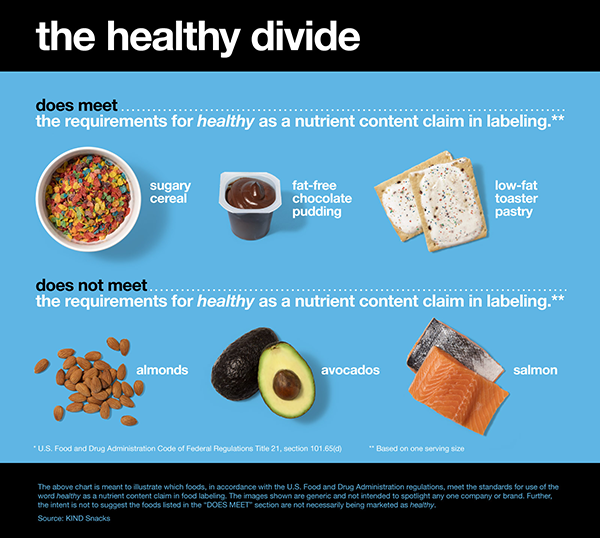Finally, the Government Is Looking at What the Word ‘Healthy’ Really Means

Photo: Getty Images
For decades, consumers committed to a healthy lifestyle have been bombarded with countless so-called healthy brands, diets, and ingredients. The Food and Drug Administration (FDA) has finally stepped in to try to give consumers clarity and put a stop to mislabeling. The agency is asking for public input on a range of questions about how Americans define “healthy” in an effort to change the official meaning of the word for food labeling.
“As our understanding about nutrition has evolved, we need to make sure the definition for the ‘healthy’ labeling claim stays up to date,” Douglas Balentine, PhD, director of the Office of Nutrition and Food Labeling at the FDA’s Center for Food Safety and Applied Nutrition, wrote on FDA.gov. “For instance, the most recent public health recommendations now focus on type of fat, rather than amount of fat. They focus on added sugars, which consumers will see on the new Nutrition Facts label. And they focus on nutrients that consumers aren’t getting enough of, like vitamin D and potassium. By updating the definition, we hope more companies will use the ‘healthy’ claim as the basis for new product innovation and reformulation, providing consumers with a greater variety of ‘healthy’ choices in the marketplace.”
Avo Toast forever ????⭐️ #hippielaneshapes
A photo posted by HIPPIE LANE (@talinegabriel) on Jun 1, 2016 at 2:12pm PDT
The FDA seems to be moving in the right direction with this update. “Nutrition science continues to provide new and better information regarding the relationship of food to health, and this new information needs to be used to bring labels and policy up to date,” says Beth C. Weitzman, PhD, professor of public health and policy at NYU. “I think the FDA is on the right track in trying to find a way to encourage manufacturers to produce better food options and to more readily alert the consumers to better food choices.”
The FDA acknowledges how difficult it is to decipher nutrition labels, and that will be the first thing to change. “Many just don’t have the time to consider the details of nutrition information on every package they purchase. In fact, most purchase decisions are made quickly, within three to five seconds,” Balentine wrote. Weitzman agrees, saying that “for many people, a dense list of numbers (calories, sodium, fiber, etc.) is confusing, and people often do not have the skill, knowledge, time, or inclination to make use of these numbers.”
The changes were spurred in part by a 2015 dispute with Kind brand snacks in which the FDA issued a warning letter demanding that Kind remove the word “healthy” from their fruit and nut bars. The letter stated that the bars couldn’t be labeled “healthy” since they contained too much saturated fat and because antioxidants are not medically proven to be beneficial. “The current regulation was established 20+ years ago,” Kind retorted in a statement. “Under it, foods like nuts, salmon and avocados cannot be labeled as healthy, but items like fat-free pudding and low-fat toaster pastries can.”

We don’t have a timeline from the FDA about when we’ll see changes to food labeling, but we’re glad to see an acknowledgement of issues and forward motion. “While we are working on the ‘healthy’ claim, we also will begin evaluating other label claims to determine how they might be modernized. We want to give consumers the best tools and information about the foods they choose, with the goal of improving public health,” Balentine wrote. “The end result will be more healthy dietary choices for consumers, and that is a worthy goal.”
Let’s keep in touch! Follow Yahoo Beauty on Facebook, Twitter, Instagram, and Pinterest.

